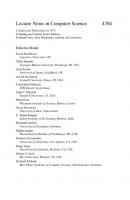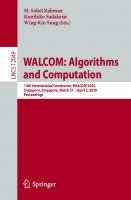Provable and Practical Security: 14th International Conference, ProvSec 2020, Singapore, November 29 – December 1, 2020, Proceedings 9783030625757, 9783030625764
This book constitutes the refereed proceedings of the 14th International Conference on Provable Security, ProvSec 2020,
310 119 12MB
English Pages 423 [426] Year 2020
Table of contents :
Preface
Organization
Contents
Signature Schemes
Group Signature Without Random Oracles from Randomizable Signatures
1 Introduction
2 Preliminaries
2.1 Bilinear Groups
2.2 Digital Signature
2.3 Computational Assumptions
3 Group Signature
4 Our Group Signature
4.1 The Construction
4.2 Security Results
5 Efficiency Comparison
6 Conclusion
References
Constant-Size Lattice-Based Group Signature with Forward Security in the Standard Model
1 Introduction
1.1 Our Contribution
1.2 Overview of the Building Blocks for Our Construction
1.3 Our Construction
2 Preliminaries
2.1 Lattices and Trapdoors
2.2 Delegation Functions
2.3 Evaluation Functions
2.4 Building Blocks for Our Construction
3 Forward-Secure Indexed Attribute-Based Signature Scheme from Lattices
3.1 Framework and Security Properties
3.2 Construction of FSI-ABS Scheme from Lattices
3.3 Security Proofs
4 Forward-Secure Group Signature Scheme
4.1 Forward-Secure Group Signature from Lattices
4.2 Security
References
A Lattice-Based Provably Secure Multisignature Scheme in Quantum Random Oracle Model
1 Introduction
1.1 Our Contribution
1.2 Future Works
2 Preliminaries
2.1 Quantum Computation
2.2 Quantum Random Oracle Model
2.3 Lattice
2.4 Multisignature Scheme
3 A Dilithium-Based Multisignature Scheme
3.1 Supporting Algorithms
3.2 Proposed Scheme
3.3 Security
References
Achieving Pairing-Free Aggregate Signatures using Pre-Communication between Signers
1 Introduction
1.1 Properties of Aggregate Signatures and Multi-signatures
1.2 Our Contributions
1.3 Difficulty and Our Techniques
1.4 Related Work
2 Preliminaries
2.1 Notation
2.2 Hardness Assumption
3 Aggregate Signatures with Pre-Communication
3.1 Definition
3.2 Our AS Scheme with PreCom (PCAS)
4 Performance Comparison among Aggregate Signature Scheme and Related Schemes
5 How to Avoid Drijvers et al.'s Impossibility
6 Conclusion
References
Short Lattice Signatures in the Standard Model with Efficient Tag Generation
1 Introduction
1.1 Background
1.2 Related Works
1.3 Contributions
2 Preliminaries
2.1 Digital Signatures
2.2 Security Classes
2.3 Lattice and Gaussian
2.4 Lattice Trapdoor
2.5 Trapdoor Commitments
3 Mildly Secure Scheme
3.1 Tags
3.2 Construction
3.3 Security Analysis
4 Fully Secure Scheme
4.1 Conditions of TCOM
4.2 Construction
4.3 Security Analysis
5 Reduction Loss
6 Conclusion
A Proof of Theorem 2
References
One-Time Delegation of Unlinkable Signing Rights and Its Application
1 Introduction
2 Preliminaries
3 One-Time Delegation of Okamoto-Schnorr Signing
3.1 Instantiating OS Signing OTP with Clouds
4 One-Time Multi-Run-Detectable Delegation Based on Anonymous Credentials
5 E-Cash Based on Signing OTPs
References
Watermarkable Signature with Computational Function Preserving
1 Introduction
1.1 Backgrounds
1.2 Our Contributions
1.3 Related Works
1.4 Road Map
1.5 Notations
2 Watermarkable Signature
3 Construction
3.1 Correctness and Security Proof
4 Relation with Previous Definitions of Watermarking
5 Conclusions
A Basic Cryptographic Primitives
A.1 Public Key Encryption
A.2 Digital Signature
B Watermarkable Signature in Previous Works
B.1 Definition by Goyal et al. ch7GKMsps19
B.2 Definition by Cohen et al. ch7CHNsps16
References
Privacy-Preserving Authentication for Tree-Structured Data with Designated Verification in Outsourced Environments
1 Introduction
1.1 Organization
2 Related Work
3 Preliminaries
3.1 Complexity Assumption
3.2 Secure Naming Scheme
4 Definitions of Our DV-PPAT
4.1 Syntax of DV-PPAT
4.2 Notions of Security for DV-PPAT
5 Our Construction
5.1 Security Results
6 Performance Evaluation
7 Conclusions
References
Encryption Schemes and NIZKs
Semi-Adaptively Secure Offline Witness Encryption from Puncturable Witness PRF
1 Introduction
2 Preliminaries
2.1 Pseudorandom Generator
2.2 Puncturable Pseudorandom Function
2.3 Symmetric Key Encryption
2.4 Puncturable Witness Pseudorandom Function
2.5 Offline Witness Encryption
2.6 Obfuscation
3 Construction: (Extractable) Offline Witness Encryption
4 Informal Description: (Extractable) Offline Functional Witness Encryption
5 Construction: Puncturable Witness(-Extractable) Pseudorandom Function
6 Conclusion
A Formal Proof of Theorem 3
References
Improved Indistinguishability for Searchable Symmetric Encryption
1 Introduction
2 Preliminaries
2.1 Leakage Function
2.2 SSE Security Model
2.3 Practical Attacks
3 Redefining SSE Indistinguishability
3.1 Security Goals
3.2 Adversary Models
3.3 Relation to Current Security Definitions
4 o o -B
4.1 IND-CKA by ALOA
4.2 Count Attack by AKDDA
5 o o -B with Cluster Padding
5.1 IND-CKA by AKFDA
5.2 File Injection Attack by ALOA
6 Conclusion
A L-security by ch10SECD:ChaseK10
B SSE Indistinguishability by ch10SSE:CurtmolaGKO06
C o o -B
D Result-Hiding o o -B
References
Receiver Selective Opening CCA Secure Public Key Encryption from Various Assumptions
1 Introduction
1.1 Background and Motivation
1.2 Our Contribution
1.3 Related Work
2 Preliminaries
2.1 Notations
2.2 Public Key Encryption
2.3 Receiver Non-committing Encryption
2.4 Signature
2.5 Commitment
2.6 Designated-Verifier Non-interactive Zero-Knowledge Arguments
3 Construction of One-Time Simulation Sound DV-NIZK
3.1 Description
3.2 Security Proof
4 Construction of RNC-CCA Secure RNCE
4.1 Description
4.2 Security Proof
References
A Practical NIZK Argument for Confidential Transactions over Account-Model Blockchain
1 Introduction
1.1 Our Contributions
1.2 Technical Overview
2 Preliminaries
2.1 Cryptographic Primitives
2.2 Zero Knowledge Proof
2.3 Smart Contracts for Payment over Blockchains
3 NIZK Argument and Its Application to CTSC
3.1 Definition of CTSC Scheme
3.2 Non-interactive Zero-Knowledge Argument
3.3 Construction of CTSC Scheme
4 Optimization and Evaluation
4.1 Optimization
4.2 Evaluation
A Missing Proof of Theorem 1
References
Secure Machine Learning and Multiparty Computation
Secure Cumulative Reward Maximization in Linear Stochastic Bandits
1 Introduction
2 Preliminaries
3 LinUCB-DS
4 Security Analysis
5 Experiments
6 Adaptability of LinUCB-DS
7 Conclusions
A Appendix: Security Proofs for Sect.4
References
Secure Transfer Learning for Machine Fault Diagnosis Under Different Operating Conditions
1 Introduction
2 Preliminaries
2.1 Fully Homomorphic Encryption
2.2 Neural Network Inference and Training
2.3 Transfer Learning
3 PrivGD: Secure Neural Network Training with FHE
3.1 Matrix Multiplications with Packed FHE Ciphertexts
3.2 Neural Network Training with FHE
3.3 Multi-class Classifier Training in FHE with Approximated Softmax
3.4 Current Challenges and Our Approach
4 Secure Transfer Learning for Personalized Machine Fault Diagnosis
4.1 The Machine Vibration Sensor Datasets
4.2 Network Model for Machine Fault Diagnosis
4.3 Secure Model Fine-Tuning Across Different Operating Conditions
4.4 Implementation of Secure Fine-Tuning Process
4.5 FHE Parameters Selection
5 Experiment Evaluation
5.1 Experiment Server Setup
5.2 Experiment Results
5.3 Running Performances of Fine-Tuning with FHE
6 Related Work
7 Conclusion
References
Private Decision Tree Evaluation with Constant Rounds via (Only) SS-3PC over Ring
1 Introduction
1.1 Backgrounds
1.2 Our Results
1.3 Related Work
2 Preliminaries
2.1 Notations
2.2 2-Out-of-3 Replicated Secret Sharing Scheme ((2,3)-RSS) and 2-Out-of-2 Additive Secret Sharing Scheme ((2,2)-ASS)
2.3 Secure Three-Party Computation with One Corruption over Ring
2.4 Structure of Decision Tree
2.5 Building Blocks of Three-Party Computation Protocol over Ring
3 Proposed Protocol in Feature Selection Phase
4 Proposed Protocol in Comparison Phase
5 Proposed Protocol in Path Evaluation Phase
6 Proposed Protocol of Private Decision Tree Evaluation
7 Security Proof
8 Conclusion
A Naive Construction of PDTE
References
Dispelling Myths on Superposition Attacks: Formal Security Model and Attack Analyses
1 Introduction
2 Preliminaries
3 New Security Model for Superposition Attacks
4 The Modified Honest-but-Curious Yao Protocol
4.1 Definitions for Symmetric Encryption Schemes
4.2 The Original Yao Protocol
4.3 Presentation of the Modified Yao Protocol
5 Analysis of Yao's Protocol with Superposition Access
5.1 Attacking the Modified Yao Protocol via Superpositions
5.2 Superposition-Resistant Yao Protocol
6 Conclusion
References
Secret Sharing Schemes
Fair and Sound Secret Sharing from Homomorphic Time-Lock Puzzles
1 Introduction
1.1 Our Contributions
2 Definitions and Modelling
2.1 Secret Sharing
2.2 Rational Secret Sharing
2.3 Homomorphic TLPs
3 A Fair and Sound Non-simultaneous Rational Secret Sharing Scheme
3.1 Our Construction
3.2 A Concrete Instantiation
References
Optimal Threshold Changeable Secret Sharing with New Threshold Change Range
1 Introduction
2 Preliminaries
3 Constructions with New Threshold Change Range
3.1 Generic Construction
3.2 New Optimal Threshold Changeable Secret Sharing
3.3 Extending the Results to Universal Threshold Change
4 Completeness Results for Secret Sharing with Full Reconstruction
5 Conclusion
References
Security Analyses
Key Recovery Under Plaintext Checking Attack on LAC
1 Introduction
1.1 Our Contributions
1.2 Techniques
1.3 Related Work
1.4 Organization
2 Preliminaries
2.1 Mathematical Notations
2.2 KR-PCA Attack
2.3 LAC.CPA
3 KR-PCA Attack on LAC.CPA
3.1 Choosing Special m
3.2 Choosing m Randomly
3.3 Attack on LAC-256
3.4 Number of Queries and Probability of Success
4 Recovering Reused Key in LAC.KE
5 Conclusion
References
Security of Two NIST Candidates in the Presence of Randomness Reuse
1 Introduction
1.1 Our Contributions
1.2 Techniques
1.3 Related Work
1.4 Organization
2 Preliminaries
2.1 Mathematical Notations
2.2 RLWE Problem
2.3 Cryptographic Definitions
2.4 NewHope-CPA-PKE
2.5 LAC.CPA
3 A Meta-PKE Construction
4 A Feature of Meta-PKE
5 The Recovery of Reused Randomness in NewHope-CPA-KEM and LAC.KE
5.1 The Reused Randomness Recovery Game
5.2 Recovering Randomness in NewHope-CPA-KEM
5.3 Recovering Randomness in LAC.KE
5.4 Recovering the Shared Secret in Another Session
6 Conclusion
References
Author Index
Preface
Organization
Contents
Signature Schemes
Group Signature Without Random Oracles from Randomizable Signatures
1 Introduction
2 Preliminaries
2.1 Bilinear Groups
2.2 Digital Signature
2.3 Computational Assumptions
3 Group Signature
4 Our Group Signature
4.1 The Construction
4.2 Security Results
5 Efficiency Comparison
6 Conclusion
References
Constant-Size Lattice-Based Group Signature with Forward Security in the Standard Model
1 Introduction
1.1 Our Contribution
1.2 Overview of the Building Blocks for Our Construction
1.3 Our Construction
2 Preliminaries
2.1 Lattices and Trapdoors
2.2 Delegation Functions
2.3 Evaluation Functions
2.4 Building Blocks for Our Construction
3 Forward-Secure Indexed Attribute-Based Signature Scheme from Lattices
3.1 Framework and Security Properties
3.2 Construction of FSI-ABS Scheme from Lattices
3.3 Security Proofs
4 Forward-Secure Group Signature Scheme
4.1 Forward-Secure Group Signature from Lattices
4.2 Security
References
A Lattice-Based Provably Secure Multisignature Scheme in Quantum Random Oracle Model
1 Introduction
1.1 Our Contribution
1.2 Future Works
2 Preliminaries
2.1 Quantum Computation
2.2 Quantum Random Oracle Model
2.3 Lattice
2.4 Multisignature Scheme
3 A Dilithium-Based Multisignature Scheme
3.1 Supporting Algorithms
3.2 Proposed Scheme
3.3 Security
References
Achieving Pairing-Free Aggregate Signatures using Pre-Communication between Signers
1 Introduction
1.1 Properties of Aggregate Signatures and Multi-signatures
1.2 Our Contributions
1.3 Difficulty and Our Techniques
1.4 Related Work
2 Preliminaries
2.1 Notation
2.2 Hardness Assumption
3 Aggregate Signatures with Pre-Communication
3.1 Definition
3.2 Our AS Scheme with PreCom (PCAS)
4 Performance Comparison among Aggregate Signature Scheme and Related Schemes
5 How to Avoid Drijvers et al.'s Impossibility
6 Conclusion
References
Short Lattice Signatures in the Standard Model with Efficient Tag Generation
1 Introduction
1.1 Background
1.2 Related Works
1.3 Contributions
2 Preliminaries
2.1 Digital Signatures
2.2 Security Classes
2.3 Lattice and Gaussian
2.4 Lattice Trapdoor
2.5 Trapdoor Commitments
3 Mildly Secure Scheme
3.1 Tags
3.2 Construction
3.3 Security Analysis
4 Fully Secure Scheme
4.1 Conditions of TCOM
4.2 Construction
4.3 Security Analysis
5 Reduction Loss
6 Conclusion
A Proof of Theorem 2
References
One-Time Delegation of Unlinkable Signing Rights and Its Application
1 Introduction
2 Preliminaries
3 One-Time Delegation of Okamoto-Schnorr Signing
3.1 Instantiating OS Signing OTP with Clouds
4 One-Time Multi-Run-Detectable Delegation Based on Anonymous Credentials
5 E-Cash Based on Signing OTPs
References
Watermarkable Signature with Computational Function Preserving
1 Introduction
1.1 Backgrounds
1.2 Our Contributions
1.3 Related Works
1.4 Road Map
1.5 Notations
2 Watermarkable Signature
3 Construction
3.1 Correctness and Security Proof
4 Relation with Previous Definitions of Watermarking
5 Conclusions
A Basic Cryptographic Primitives
A.1 Public Key Encryption
A.2 Digital Signature
B Watermarkable Signature in Previous Works
B.1 Definition by Goyal et al. ch7GKMsps19
B.2 Definition by Cohen et al. ch7CHNsps16
References
Privacy-Preserving Authentication for Tree-Structured Data with Designated Verification in Outsourced Environments
1 Introduction
1.1 Organization
2 Related Work
3 Preliminaries
3.1 Complexity Assumption
3.2 Secure Naming Scheme
4 Definitions of Our DV-PPAT
4.1 Syntax of DV-PPAT
4.2 Notions of Security for DV-PPAT
5 Our Construction
5.1 Security Results
6 Performance Evaluation
7 Conclusions
References
Encryption Schemes and NIZKs
Semi-Adaptively Secure Offline Witness Encryption from Puncturable Witness PRF
1 Introduction
2 Preliminaries
2.1 Pseudorandom Generator
2.2 Puncturable Pseudorandom Function
2.3 Symmetric Key Encryption
2.4 Puncturable Witness Pseudorandom Function
2.5 Offline Witness Encryption
2.6 Obfuscation
3 Construction: (Extractable) Offline Witness Encryption
4 Informal Description: (Extractable) Offline Functional Witness Encryption
5 Construction: Puncturable Witness(-Extractable) Pseudorandom Function
6 Conclusion
A Formal Proof of Theorem 3
References
Improved Indistinguishability for Searchable Symmetric Encryption
1 Introduction
2 Preliminaries
2.1 Leakage Function
2.2 SSE Security Model
2.3 Practical Attacks
3 Redefining SSE Indistinguishability
3.1 Security Goals
3.2 Adversary Models
3.3 Relation to Current Security Definitions
4 o o -B
4.1 IND-CKA by ALOA
4.2 Count Attack by AKDDA
5 o o -B with Cluster Padding
5.1 IND-CKA by AKFDA
5.2 File Injection Attack by ALOA
6 Conclusion
A L-security by ch10SECD:ChaseK10
B SSE Indistinguishability by ch10SSE:CurtmolaGKO06
C o o -B
D Result-Hiding o o -B
References
Receiver Selective Opening CCA Secure Public Key Encryption from Various Assumptions
1 Introduction
1.1 Background and Motivation
1.2 Our Contribution
1.3 Related Work
2 Preliminaries
2.1 Notations
2.2 Public Key Encryption
2.3 Receiver Non-committing Encryption
2.4 Signature
2.5 Commitment
2.6 Designated-Verifier Non-interactive Zero-Knowledge Arguments
3 Construction of One-Time Simulation Sound DV-NIZK
3.1 Description
3.2 Security Proof
4 Construction of RNC-CCA Secure RNCE
4.1 Description
4.2 Security Proof
References
A Practical NIZK Argument for Confidential Transactions over Account-Model Blockchain
1 Introduction
1.1 Our Contributions
1.2 Technical Overview
2 Preliminaries
2.1 Cryptographic Primitives
2.2 Zero Knowledge Proof
2.3 Smart Contracts for Payment over Blockchains
3 NIZK Argument and Its Application to CTSC
3.1 Definition of CTSC Scheme
3.2 Non-interactive Zero-Knowledge Argument
3.3 Construction of CTSC Scheme
4 Optimization and Evaluation
4.1 Optimization
4.2 Evaluation
A Missing Proof of Theorem 1
References
Secure Machine Learning and Multiparty Computation
Secure Cumulative Reward Maximization in Linear Stochastic Bandits
1 Introduction
2 Preliminaries
3 LinUCB-DS
4 Security Analysis
5 Experiments
6 Adaptability of LinUCB-DS
7 Conclusions
A Appendix: Security Proofs for Sect.4
References
Secure Transfer Learning for Machine Fault Diagnosis Under Different Operating Conditions
1 Introduction
2 Preliminaries
2.1 Fully Homomorphic Encryption
2.2 Neural Network Inference and Training
2.3 Transfer Learning
3 PrivGD: Secure Neural Network Training with FHE
3.1 Matrix Multiplications with Packed FHE Ciphertexts
3.2 Neural Network Training with FHE
3.3 Multi-class Classifier Training in FHE with Approximated Softmax
3.4 Current Challenges and Our Approach
4 Secure Transfer Learning for Personalized Machine Fault Diagnosis
4.1 The Machine Vibration Sensor Datasets
4.2 Network Model for Machine Fault Diagnosis
4.3 Secure Model Fine-Tuning Across Different Operating Conditions
4.4 Implementation of Secure Fine-Tuning Process
4.5 FHE Parameters Selection
5 Experiment Evaluation
5.1 Experiment Server Setup
5.2 Experiment Results
5.3 Running Performances of Fine-Tuning with FHE
6 Related Work
7 Conclusion
References
Private Decision Tree Evaluation with Constant Rounds via (Only) SS-3PC over Ring
1 Introduction
1.1 Backgrounds
1.2 Our Results
1.3 Related Work
2 Preliminaries
2.1 Notations
2.2 2-Out-of-3 Replicated Secret Sharing Scheme ((2,3)-RSS) and 2-Out-of-2 Additive Secret Sharing Scheme ((2,2)-ASS)
2.3 Secure Three-Party Computation with One Corruption over Ring
2.4 Structure of Decision Tree
2.5 Building Blocks of Three-Party Computation Protocol over Ring
3 Proposed Protocol in Feature Selection Phase
4 Proposed Protocol in Comparison Phase
5 Proposed Protocol in Path Evaluation Phase
6 Proposed Protocol of Private Decision Tree Evaluation
7 Security Proof
8 Conclusion
A Naive Construction of PDTE
References
Dispelling Myths on Superposition Attacks: Formal Security Model and Attack Analyses
1 Introduction
2 Preliminaries
3 New Security Model for Superposition Attacks
4 The Modified Honest-but-Curious Yao Protocol
4.1 Definitions for Symmetric Encryption Schemes
4.2 The Original Yao Protocol
4.3 Presentation of the Modified Yao Protocol
5 Analysis of Yao's Protocol with Superposition Access
5.1 Attacking the Modified Yao Protocol via Superpositions
5.2 Superposition-Resistant Yao Protocol
6 Conclusion
References
Secret Sharing Schemes
Fair and Sound Secret Sharing from Homomorphic Time-Lock Puzzles
1 Introduction
1.1 Our Contributions
2 Definitions and Modelling
2.1 Secret Sharing
2.2 Rational Secret Sharing
2.3 Homomorphic TLPs
3 A Fair and Sound Non-simultaneous Rational Secret Sharing Scheme
3.1 Our Construction
3.2 A Concrete Instantiation
References
Optimal Threshold Changeable Secret Sharing with New Threshold Change Range
1 Introduction
2 Preliminaries
3 Constructions with New Threshold Change Range
3.1 Generic Construction
3.2 New Optimal Threshold Changeable Secret Sharing
3.3 Extending the Results to Universal Threshold Change
4 Completeness Results for Secret Sharing with Full Reconstruction
5 Conclusion
References
Security Analyses
Key Recovery Under Plaintext Checking Attack on LAC
1 Introduction
1.1 Our Contributions
1.2 Techniques
1.3 Related Work
1.4 Organization
2 Preliminaries
2.1 Mathematical Notations
2.2 KR-PCA Attack
2.3 LAC.CPA
3 KR-PCA Attack on LAC.CPA
3.1 Choosing Special m
3.2 Choosing m Randomly
3.3 Attack on LAC-256
3.4 Number of Queries and Probability of Success
4 Recovering Reused Key in LAC.KE
5 Conclusion
References
Security of Two NIST Candidates in the Presence of Randomness Reuse
1 Introduction
1.1 Our Contributions
1.2 Techniques
1.3 Related Work
1.4 Organization
2 Preliminaries
2.1 Mathematical Notations
2.2 RLWE Problem
2.3 Cryptographic Definitions
2.4 NewHope-CPA-PKE
2.5 LAC.CPA
3 A Meta-PKE Construction
4 A Feature of Meta-PKE
5 The Recovery of Reused Randomness in NewHope-CPA-KEM and LAC.KE
5.1 The Reused Randomness Recovery Game
5.2 Recovering Randomness in NewHope-CPA-KEM
5.3 Recovering Randomness in LAC.KE
5.4 Recovering the Shared Secret in Another Session
6 Conclusion
References
Author Index

- Author / Uploaded
- Khoa Nguyen
- Wenling Wu
- Kwok Yan
- Lam Huaxiong Wang
![Provable and Practical Security: 14th International Conference, ProvSec 2020, Singapore, November 29 – December 1, 2020, Proceedings [1st ed.]
9783030625757, 9783030625764](https://ebin.pub/img/200x200/provable-and-practical-security-14th-international-conference-provsec-2020-singapore-november-29-december-1-2020-proceedings-1st-ed-9783030625757-9783030625764.jpg)
![Security Standardisation Research: 6th International Conference, SSR 2020, London, UK, November 30 – December 1, 2020, Proceedings [1st ed.]
9783030643560, 9783030643577](https://ebin.pub/img/200x200/security-standardisation-research-6th-international-conference-ssr-2020-london-uk-november-30-december-1-2020-proceedings-1st-ed-9783030643560-9783030643577.jpg)




![Technologies and Innovation: 6th International Conference, CITI 2020, Guayaquil, Ecuador, November 30 – December 3, 2020, Proceedings [1st ed.]
9783030620141, 9783030620158](https://ebin.pub/img/200x200/technologies-and-innovation-6th-international-conference-citi-2020-guayaquil-ecuador-november-30-december-3-2020-proceedings-1st-ed-9783030620141-9783030620158.jpg)


